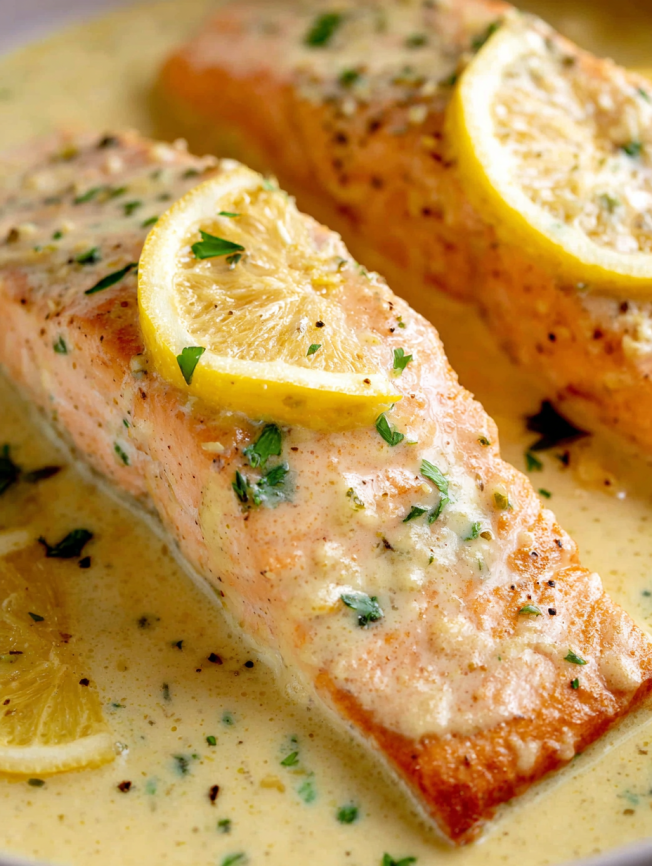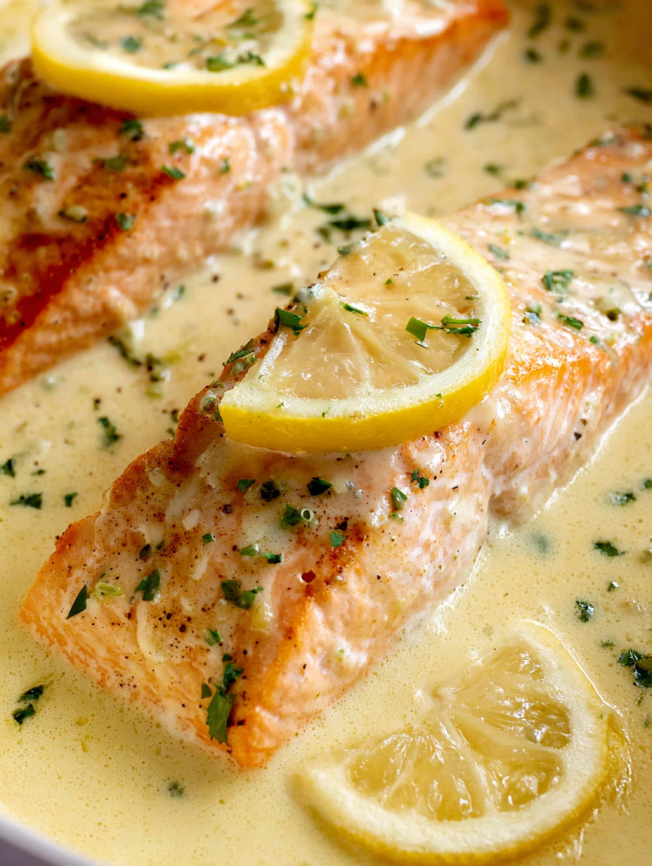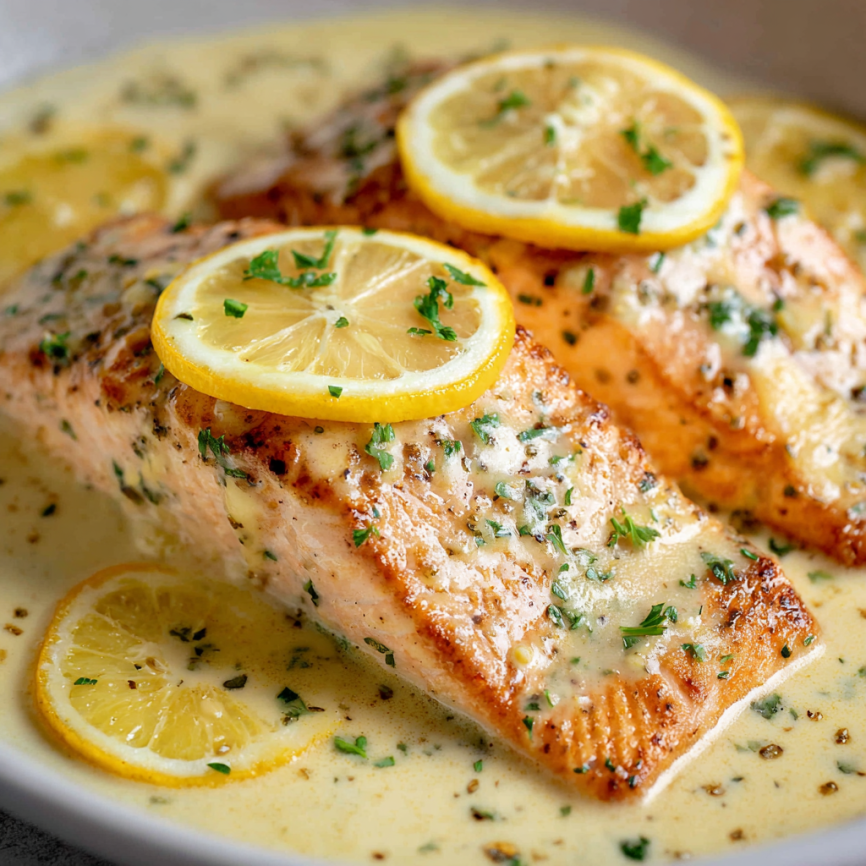There’s something magical about the way a perfectly cooked salmon fillet flakes apart under your fork, especially when it’s bathed in a velvety lemon butter sauce that’s so irresistible you’ll want to drink it straight from the pan. I discovered this truth during one of those hectic weeknight dinners when I needed something impressive yet achievable in under 30 minutes.
After years of overcomplicating salmon recipes, I finally found the perfect balance between simplicity and sophistication. This dish proves that restaurant-quality meals don’t require hours of preparation or exotic ingredients. Instead, it relies on the natural richness of salmon enhanced by a silky cream sauce that transforms ordinary weeknight cooking into something extraordinary.
Why This Recipe Will Transform Your Dinner Routine
Foolproof Technique
Unlike pan-seared methods that require precise timing, baking salmon provides consistent results every time. The gentle oven heat ensures the fish cooks evenly while you prepare the luxurious sauce on the stovetop.
Time-Efficient Excellence
In just 25 minutes, you’ll have a complete meal that looks and tastes like it came from an upscale restaurant. The simultaneous cooking method maximizes efficiency without sacrificing quality.
Impressive Presentation
The creamy lemon butter sauce creates an elegant pooling effect around the salmon, making even the simplest plating look professional. Guests will assume you spent hours perfecting this dish.
Versatile Foundation
This recipe serves as an excellent base for countless variations. You can easily adapt the flavors to match seasonal ingredients or personal preferences while maintaining the core technique.
Essential Ingredients for Success
Salmon Components
- 4 skinless salmon fillets (6-8 oz each for best results)
- 2 tablespoons fresh lemon juice, divided
- 1 tablespoon olive oil (extra virgin preferred)
- 1 tablespoon minced garlic
- 2 tablespoons dry white wine (optional, can substitute with 2 teaspoons Dijon mustard)
- Salt and pepper for seasoning
Cream Sauce Elements
- 1/4 cup unsalted butter (essential for richness)
- 2 teaspoons minced garlic (separate from salmon portion)
- 2 tablespoons dry white wine (or 1 teaspoon Dijon mustard)
- 1/2 cup heavy cream (whipping or thickened cream works too)
- 1-2 tablespoons fresh lemon juice (adjust to taste)
- 1 tablespoon fresh parsley, chopped and divided
Step-by-Step Preparation Guide
Oven Preparation
Preheat your oven to 425°F (220°C). This temperature ensures the salmon cooks through without drying out while developing a lovely exterior. Lightly grease a baking dish that can accommodate all four fillets without overcrowding.
Salmon Preparation
Pat the salmon fillets completely dry with paper towels – this step is crucial for proper seasoning adherence. In a small bowl, whisk together lemon juice, olive oil, minced garlic, and wine until well combined.
Seasoning Process
Rub the salmon fillets thoroughly with the prepared mixture, ensuring every surface is coated. Arrange the seasoned fillets in your prepared baking dish, then season generously with salt and pepper.
Baking Technique
Bake the salmon for 10-12 minutes, depending on thickness. The fish should appear opaque throughout and flake easily when tested with a fork. Avoid overbaking, as this leads to dry, tough salmon.
Sauce Creation
While the salmon bakes, begin the cream sauce by melting butter in a small saucepan over medium heat. Add minced garlic and cook for just 30 seconds until fragrant – longer cooking can make garlic bitter.
Wine Reduction
Pour in the wine and allow it to simmer for 2-3 minutes until it begins to reduce slightly. This step concentrates the flavors and removes the raw alcohol taste.
Cream Integration
Add the cream and continue cooking until the sauce thickens slightly, about 2-3 minutes. The sauce should coat the back of a spoon but remain pourable.
Final Assembly
Remove the sauce from heat and stir in fresh lemon juice and half the chopped parsley. Pour the warm sauce over the baked salmon, allowing it to mingle with the natural pan juices for maximum flavor integration.

Serving Suggestions and Pairings
Classic Accompaniments
This elegant salmon pairs beautifully with roasted asparagus, steamed broccoli, or sautéed green beans. The cream sauce complements these vegetables without overwhelming their natural flavors.
Starch Options
Consider serving over a bed of fluffy rice pilaf, creamy mashed potatoes, or al dente pasta. Each option soaks up the luxurious sauce differently, creating unique textural experiences.
Wine Pairings
A crisp Chardonnay or Pinot Grigio complements the richness of the cream sauce while enhancing the salmon’s natural flavors. For red wine lovers, a light Pinot Noir works surprisingly well.
Creative Variations to Explore
Herb Enhancements
Experiment with different fresh herbs to create unique flavor profiles. Fresh dill pairs classically with salmon, while tarragon adds French sophistication. Basil creates an Italian-inspired variation that’s equally delicious.
Citrus Alternatives
While lemon is traditional, try substituting with lime juice for a more tropical flavor or orange juice for subtle sweetness. Each citrus brings its own character to the dish.
Dietary Adaptations
For a lighter version, substitute the heavy cream with half-and-half or coconut cream. You can also use Greek yogurt whisked with a little milk for a protein-rich alternative.
Make-Ahead Strategies
Prep Work Solutions
The salmon can be seasoned and stored covered in the refrigerator for up to 4 hours before baking. This advance preparation actually enhances the flavor penetration.
Sauce Components
You can prepare the sauce base (butter, garlic, and wine reduction) several hours ahead, then simply add the cream and finish with lemon juice when ready to serve.
Professional Tips for Perfect Results
Doneness Guidelines
Medium doneness: Bake for 4 minutes per 1/2-inch of thickness. Well done: Increase to 6 minutes per 1/2-inch of thickness. Always measure at the thickest part of the fillet.
Temperature Monitoring
Use an instant-read thermometer to check for doneness. The USDA recommends a minimum internal temperature of 145°F (61°C), measured in the thickest part of the salmon.
Quality Indicators
Properly cooked salmon should flake easily when tested with a fork, appearing opaque throughout with no translucent areas. The flesh should separate into clean, moist flakes.
Storage and Reheating
Store leftovers in an airtight container in the refrigerator for up to 3 days. Gently reheat in the microwave at 50% power to prevent overcooking.

Frequently Asked Questions
Q: Can I use frozen salmon for this recipe? A: Yes, but ensure it’s completely thawed and patted dry before seasoning. Frozen salmon may release more moisture during cooking, so you might need to adjust the baking time slightly.
Q: What if I don’t have white wine? A: Substitute with an equal amount of chicken broth, additional lemon juice, or simply omit it entirely. The Dijon mustard alternative mentioned in the recipe also works wonderfully.
Q: How do I prevent the cream sauce from curdling? A: Keep the heat at medium or below when adding the cream, and don’t let it boil vigorously. If it does start to separate, remove from heat and whisk in a tablespoon of cold butter.
Q: Can I make this recipe with skin-on salmon? A: Absolutely! Place the fillets skin-side down in the baking dish. The skin will help protect the fish from overcooking and can be easily removed after baking if desired.
Q: What’s the best way to tell if my salmon is overcooked? A: Overcooked salmon becomes dry, flaky, and loses its vibrant color. It may also release white protein (albumin) on the surface. Properly cooked salmon should be moist and slightly firm.
Q: Can I prepare this recipe for a larger crowd? A: Certainly! Simply multiply the ingredients proportionally and use multiple baking dishes if necessary. Avoid overcrowding, as this can lead to uneven cooking.
Q: How do I reheat the salmon without drying it out? A: Reheat gently in the microwave at 50% power, or place in a 300°F oven covered with foil for 8-10 minutes. Add a splash of water or extra sauce to maintain moisture.
Prep Time: 5 minutes | Cook Time: 20 minutes | Total Time: 25 minutes | Servings: 4
Nutritional Information per serving: 496 calories, 3g carbohydrates, 35g protein, 37g fat
Pro tip: The secret to this incredible sauce is removing it from heat before adding the lemon juice – this prevents the cream from curdling and maintains that silky smooth texture you’ll absolutely love!

